Import email, contacts, and calendar from an Outlook .pst file
When an Outlook app - such as Outlook 2016 - is installed on your computer, you can use it to move email, contacts, and calendar items from one email account to another.
For example, let's say you have an Office 365 mailbox and a Gmail account. You can add both of them to Outlook 2016. Then, you can use Outlook 2016 to export items from your Gmail account and import them to your Office 365 mailbox.
How to import email, contacts, and calendar to Outlook from a .pst file
Choose from the following list of import instructions. To create a .pst file, see the instructions to export your email data from Outlook.
Office 365: Import a .pst file into your Office 365 mailbox
You can add your Office 365 mailbox to an Outlook app, such as Outlook 2016 or 2013. Then, you can use Outlook to move email, contacts, and calendar items into your Office 365 mailbox. Here's what you do:
-
Add your "source" email account to Outlook. For example, you might add your Gmail account to Outlook 2016. Wait a bit for all of your email and contacts to show up.
-
Add your Office 365 email account to Outlook. After you do this, Outlook will automatically sync with Office 365. You'll see the contents of your Office 365 mailbox appear in Outlook.
-
Choose from the export instructions to export your email from your source account to a .pst file.
For example, if you have Outlook 2010, choose "Outlook 2010: Export Outlook items to a .pst file".
-
Choose from the import instructions (below) in this article to import your email to Office 365.
For example, if you have Outlook 2016, choose "Outlook 2013 and Outlook 2016: Import Outlook items from a .pst file".
Because Outlook is syncing with your Office 365 email account, when you import your email using the instructions, the email will go directly into your Office 365 email account.
Outlook 2016 and 2013: Import Outlook items from a .pst file
These instructions assume you've already exported your Outlook email, contacts, and calendar from another instance of Outlook, and now you want to import them to Outlook 2013, Outlook 2016, or your Office 365 mailbox.
-
At the top of your Outlook 2016 or 2013 ribbon, choose File.
If your ribbon doesn't have a File option in the top left corner, you aren't using an Outlook app installed on your computer. See What version of Outlook do I have? to find your version of Outlook and to get to right import steps.

-
Choose Open & Export > Import/Export. This starts the wizard.
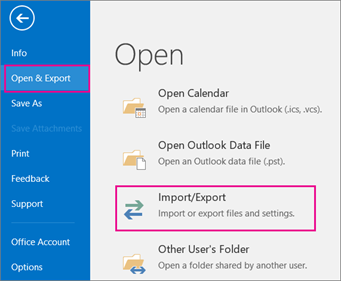
-
Choose Import from another program or file, and then click Next.
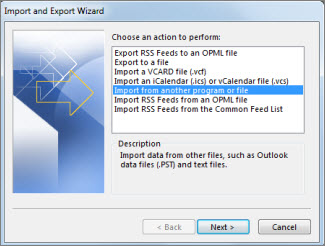
-
Choose Outlook Data File (.pst) and click Next.
-
Browse to the .pst file you want to import. Under Options, choose how you want to deal with emails and contacts, then choose Next.
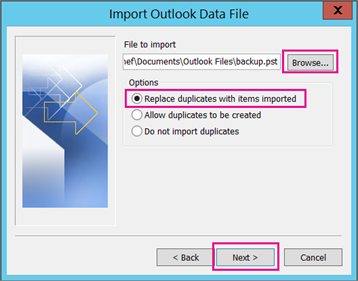
-
If a password was assigned to the Outlook Data File (.pst), enter the password, and then click OK.
-
If you're importing the contents of your .pst file into your Office 365 mailbox, choose that mailbox here.
If you're NOT importing into your Office 365 mailbox, choose Import items into the current folder. This imports the data into the folder currently selected.
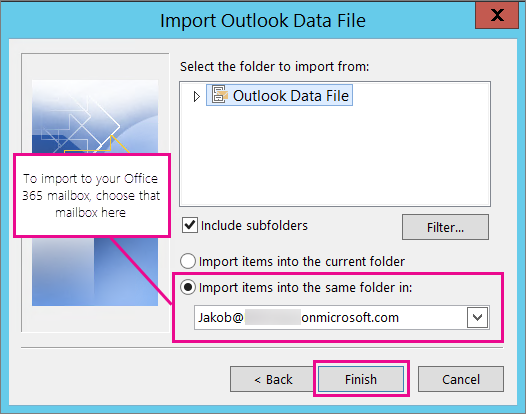
-
Choose Finish. Outlook starts importing the contents of your .pst file immediately. It's finished when the progress box goes away.
If you're importing your .pst file to your Office 365 mailbox, you may see a message that it's trying to connect with Office 365. This happens when the Internet connection is interrupted, even for a moment. Once your Internet connection is re-established, Outlook will continue importing the .pst file.
Tip: If you want to retrieve only a few emails or contacts from an Outlook Data File (.pst), you can open the Outlook Data File, and then, in the navigation pane, drag and drop the emails and contacts from .pst file to your existing Outlook folders.
If you think your .pst file is corrupted, see Repair Outlook Data Files (.pst and .ost).
Outlook 2010: Import Outlook items from a .pst file
These instructions assume you've already exported your Outlook email, contacts, and calendar from another instance of Outlook, and now you want to import them to Outlook 2010 or your Office 365 mailbox.
-
At the top of your Outlook ribbon, choose the File tab.
If your ribbon doesn't have a File option in the top left corner, you aren't using a version of Outlook installed on your computer. See What version of Outlook do I have? to find your version of Outlook and to get to right import steps.

-
Choose Open > Import. This starts the wizard.
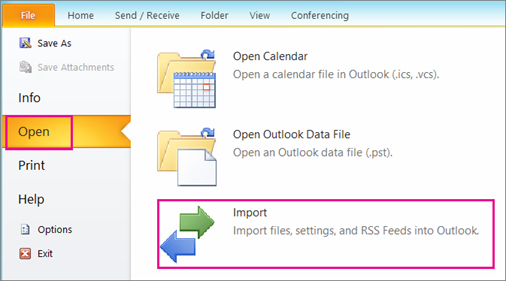
-
In the Import and Export Wizard, click Import from another program or file, and the click Next.
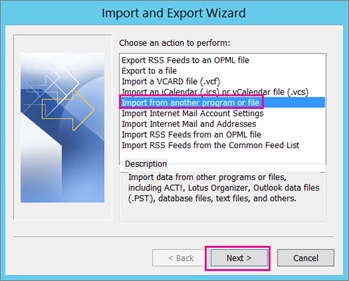
-
Select Outlook Data File (.pst), and then click Next.
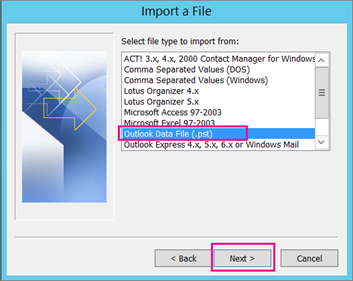
-
Choose Browse, then choose the .pst file you want to import, and choose Next.
Notes:
-
Under Options, if you want the imported information to replace duplicate items already in Outlook, choose that. Otherwise, choose Do not import duplicates.
-
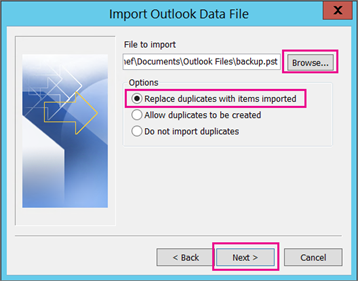
-
-
If a password was assigned to the Outlook Data File (.pst), you are prompted to enter the password, and then click OK.
-
Set the options for importing items. Choose Filter if you want to only import certain emails. Choose the More Choices tab if you want to only import emails that are read or unread.
The default settings usually don't need to be changed. The top folder — usually Personal Folders, Outlook Data File, or your email address — is selected automatically.
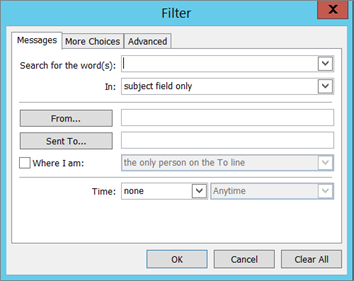
-
Include subfolders is selected by default. All folders under the folder selected will be imported.
-
Select one of the destination options:
-
Import items into the current folder - this imports the data into the folder currently selected.
-
Import items into the same folder in - this imports the data into the destination folder of the same name as the source folder, e.g., from Inbox to Inbox. If a folder doesn't exist in Outlook, it will be created.
-
-
Choose Finish. Outlook starts importing your data immediately. You'll know it's finished when the progress box closes.
Tip: If you want to retrieve only a few emails or contacts from an Outlook Data File (.pst), you can open the Outlook Data File, and then, in the navigation pane, drag and drop the emails and contacts from .pst file to your existing Outlook folders.
If you think your .pst file is corrupted, see Repair Outlook Data Files (.pst and .ost).
Outlook 2007: Import Outlook items from a .pst file
These instructions assume you've already exported your Outlook 2007 items as a backup file, and now you want to restore them. Or, you want to import them into your Office 365 mailbox.
-
At the top of our Outlook 2007 ribbon, choose File.
If your ribbon doesn't have a File option in the top left corner, you aren't using a version of Outlook installed on your computer. See What version of Outlook do I have? to find your version of Outlook and to get to right import steps.
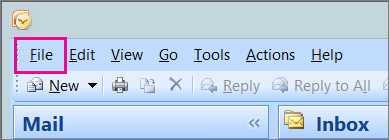
-
Choose Import and Export. This starts the wizard.
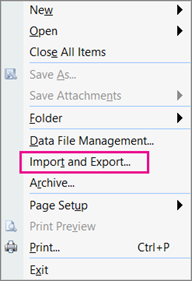
-
In the Import and Export Wizard, click Import from another program or file, and then click Next.
-
Click Personal Folders File (.pst), and then click Next.
-
Click Browse, and then choose the file to import.
Note: Under Options, it is recommended that you click Do not import duplicates unless you want the imported information to replace or duplicate items already in Outlook.
-
Click Next.
-
If a password was assigned to the Personal Folders file (.pst), you are prompted to enter the password, and then click OK.
-
Set the options for importing items. The default settings usually don't need to be changed.
-
The top folder — usually Personal Folders or your email address — is selected automatically.
-
Include subfolders is selected by default. All folders under the folder selected will be imported.
-
-
Select one of the destination options:
-
Import items into the current folder - this imports the data into the folder currently selected.
-
Import items into the same folder in - this imports the data into the destination folder of the same name as the source folder, e.g., from Inbox to Inbox. If a folder doesn't exist in Outlook, it will be created.
-
-
Click Finish.
Tip: If you want to retrieve only a few items from a Personal Folders file (.pst), you can open the Personal Folders file (.pst), and then in the navigation pane drag and drop the emails and contacts from Personal Folders file (.pst) folders to your existing Outlook folders.
When should I export/import a .pst file?
.Pst files are created when you export or back up email, contacts, and calendar to an Outlook .pst file. Here's when you should export/import a .pst file:
-
You want to move email from one email account to another email account.
For example, let's say you have an old Yahoo email account, jakobsol77@yahoo.com. And you want to move your email to a new Office 365 email account, jakobsol78@contoso.com.
Using Outlook on your desktop, you can add both accounts to Outlook. Wait a while for all of your email to show up (if you have a lot, this can be a long time). Then, use Outlook to export the email from your Yahoo account to a .pst file. Finally, import the .pst file to your Office 365 account.
-
You're moving from PC to PC: You're moving your email from one computer with Outlook on it to another computer with Outlook on it.
For example, let's say your old computer has Outlook 2007 and you just got a new computer with Outlook 2016. Export your email data from Outlook 2007 and import (described in this article) it to Outlook 2016.
-
You're moving from PC to Mac: For example, when you're moving your email from Outlook on a PC and importing to Outlook 2016 on a Mac.
-
If you only want to move or backup your contacts (email addresses), you don't need to do a .pst export/import. Instead see Export contacts from Outlook. It explains how to export (which is actually a copy) your contacts to a .csv file and then you can import them to Outlook, Gmail, or another email provider.
-
If you want to retrieve only a few emails or contacts from a .pst file, open the .pst file and then drag and drop the emails to current Outlook folders. When you're done, you can close the .pst file again.
What data is imported?
.Pst files are created when you export or back up email, contacts, and calendar to an Outlook .pst file. Outlook makes a copy of your email to the .pst file.
-
When Outlook exports emails to a .pst file, it includes any attachments. So, when you import a .pst file, you'll see your attachments.
-
Outlook does not export meta-data such as folder properties ( views, permissions, and AutoArchive settings); message rules; and blocked senders lists. So, they won't be imported, either.
-
When Outlook exports email, contacts, and calendar info to a .pst, it makes a copy of the information. Nothing is deleted from Outlook. You'll still see and have access to your email, contacts, and calendar in Outlook.
Didn't work?
See Fix problems importing an Outlook .pst file for a list of common issues and solutions.
No comments:
Post a Comment